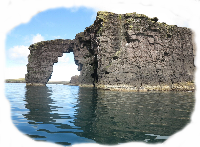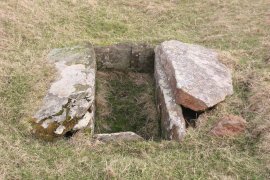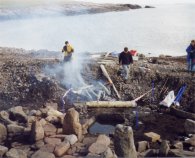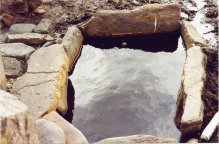
Other foundations of different shapes and of a later date are around the base of the broch, some of which could well be Pictish but as so little proof of their existence has been found anywhere in Shetland its difficult to be sure. At one time it was thought the Picts had built the brochs, but they predate the Picts arrival in Shetland and really except for the Ogham and Pictish symbol stones found elsewhere in the islands little evidence of the Picts time here seems to have survived.
In 1774 George Low wrote about this area and he mentions being at the Broch of Houlland where he removed some of the stones from the wall, to check if cement had been used, but goes on to say that he found none, confirming that the usual dry-stone building method had been used. Not far from this site is the Saebreck Broch, part of which can still be seen with a trig point and the remains of a coastguard watch hut on top of it. Another broch site is on the hill at Hamnavoe. There is reference to a fourth broch in Eshaness and to three other possible broch sites, two at Hamar Voe and one on Hillswick Ness, but some opinions suggest they were only midden sites.

There are standing stones at Hamnavoe in Eshaness. How old they are or why they were erected is a mystery. Some suggest they are from the Bronze Age and that they were erected for ritual purposes, others say they may have been used for the navigation of boats as a mead, this Shetland word means that landmarks are used to position a boat, in this case, when the stones lined up, they would know they were either, at the right position to fish, or they could turn safely into the noost or harbour entrance. Records from 1774 mention three stones standing east to west but today as can be seen on the right only two of the stones are still standing.





It is commonly believed that burnt mounds were used to boil large joints of meat or fish to alleviate the monotony of yet another roast dinner. On the day it was put to the test, stones were heated in a fire and then rolled or thrown into the cooking trough filled with water.
The water temperature did eventually rise, but it was such a slow and laborious process, it left many locals doubting the logic for this theory
The next interesting old rocks are the brochs dating from the Iron Age. Three are recorded in Eshaness, the best known being the Broch at the Loch of Houlland. This stands about 4m above ground level and cells can be seen in the wall foundations. The picture below shows the remains of the Broch, looking across the loch.
From this same period, several of the seven burnt mound sites of this area have survived
The best example is a crescent mound with a well preserved cooking trough at Burnside, Hillswick. Other ones are at the Cross Kirk, Eshaness and at Niddister on the Hillswick Ness, Hamnavoe in Eshaness and at sites near Assetter and at Heylor.
Left is the burnt mound at Burnside, Hillswick.
A few years ago a burnt mound at Tangwick, Eshaness that was under threat of erosion by the sea was used in an experiment.